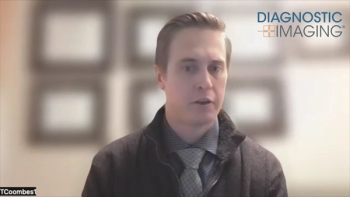
Report from RSNA: Imaging techniques fine-tune upper extremity MSK diagnoses
MR arthrography and ultrasound bring different strengths to imaging and management of joint injuries and stresses, according to research presented at the RSNA meeting. Contrast-enhanced ultrasound is a superior method of assessing neovascularity in patients with lateral epicondylitis, while MR can detect signs of recurrent carpal tunnel syndrome after surgery. A combination of MRI and ultrasound may be the most effective solution for imaging medial elbow pain.
To assess the quality of carpal tunnel decompression after surgery, median nerve and leading flexor tendon positions were compared with the line joining the hook of the hamate to ridge of trapezium. Carpal liberation was considered successful if tendon or nerve was located above the line and no tendon or nerve was entirely located below the line. (Provided by R Campagna)
MR arthrography and ultrasound bring different strengths to imaging and management of joint injuries and stresses, according to research presented at the RSNA meeting. Contrast-enhanced ultrasound is a superior method of assessing neovascularity in patients with lateral epicondylitis, while MR can detect signs of recurrent carpal tunnel syndrome after surgery. A combination of MRI and ultrasound may be the most effective solution for imaging medial elbow pain. MRI and ultrasound effectively work in conjunction to diagnose medial elbow pain in throwing athletes, said Dr. Nirav Patel of Thomas Jefferson University in Philadelphia. MR is better able to demonstrate less severe distal tears in the ulnar collateral ligament, while an abnormal ulnohumeral gap on a stress ultrasound is most useful for predicting whether subjects should go on to UCL reconstruction. A retrospective review of imaging performed in 25 throwing athletes who had both ultrasound with stress maneuvers and direct MRA found that MRA detected flexor tendon pathology in twice as many cases as ultrasound. MRA also detected bone marrow edema and cartilage lesions that ultrasound missed entirely.However, ultrasound detection of an ulnohumeral gap with valgus stress was a superior predictor of UCL reconstruction. Patients with no UCL tear showed a mean ulnohumeral gap of 1.2 mm. Those who went on to UCL reconstruction showed a mean gap of 4.3 mm.A combination protocol for imaging the throwing athlete with medial elbow pain using dynamic stress ultrasound and direct MRA identified more lesions than either modality alone, Patel said.In a study of 35 patients exhibiting symptoms of lateral epicondylitis, contrast-enhanced ultrasound proved superior to power Doppler ultrasound in detecting neovessels, said Dr. Andrea Klauser of Medizinische Universitat of Innsbruck in Austria. Contrast-enhanced ultrasound detected hyerpvascularity in 100% of symptomatic elbows, compared with 82.8% using power Doppler ultrasound. Measurement of the extent of hypervascularized areas was significantly improved by contrast-enhanced ultrasound, showing hypervascularity extending to the lateral collateral ligament and lateral synovial fringe in 71.4% of cases. Vascularity detected by contrast-enhanced ultrasound is thought to represent vessels at the microvascular level. In imaging lateral epicondylitis, contrast-enhanced ultrasound improved detection of intratendinous neovascularity and provided better delineation of avascular areas in hypervascularized tendons, which might represent tendinosis at a higher stage.Median nerve enhancement, fibrosis, enlargement at the pisiform, and insufficient carpal liberation are the most significant signs of the recurrence of carpal tunnel syndrome after corrective surgery, according to research presented by Dr. Raphael Campagna of Hôpital Cochin, AP-HP Université Paris.MRI was able to depict two of these major signs after surgery: presence of fibrosis and nerve enhancement. In a retrospective study of 48 patients with previous carpal tunnel syndrome surgical release, the researchers compared MRI results in patients with recurrent CTS and those with no symptoms. Researchers found nerve enhancement in 15 (42%) of the 36 patients in the recurrent group. Perineural fibrosis was seen in 22 (61%) of the 36 patients with recurrent carpal tunnel syndrome but only two (17%) of the 12 patients without recurrent carpal tunnel syndrome. Retinacular regrowth, size, surface, nerve ratio, nerve entrapment, and nerve high signal were not significantly different in either group.For more online information, visit Diagnostic Imaging's
Newsletter
Stay at the forefront of radiology with the Diagnostic Imaging newsletter, delivering the latest news, clinical insights, and imaging advancements for today’s radiologists.




























